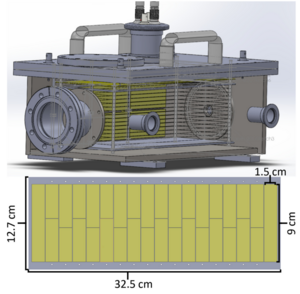ENCORE: Difference between revisions
Jump to navigation
Jump to search
(Created page with "'''Encore''' is a Multi Sampling Ionization Chamber (MUSIC) developed based on the MUSIC detector at ANL, the main difference is using field cages instead of solid aluminum plates. Because of that, higher operation voltage to optimize electron drift times.") |
No edit summary |
||
| (7 intermediate revisions by 2 users not shown) | |||
| Line 1: | Line 1: | ||
'''Encore''' is a Multi Sampling Ionization Chamber (MUSIC) developed based on the MUSIC detector at ANL, the main difference is using field cages instead of solid aluminum plates. Because of that, higher operation voltage to optimize electron drift times. | [[File:3D model of Encore.png|thumb|right|3D model of Encore]] | ||
'''Encore''' <ref name="Encore2021">B. W. Asher, S. Almaraz-Calderon, L. T. Baby, N. Gerken, E. Lopez-Saavedra, A. B. Morelock, and J. F. Perello, Nucl. Inst. Meth. Phys. A '''1014''', 165724 (2021) https://doi.org/10.1016/j.nima.2021.165724</ref> is a Multi Sampling Ionization Chamber (MUSIC) developed based on the MUSIC detector at ANL, the main difference is using field cages instead of solid aluminum plates. Because of that, higher operation voltage is needed to optimize electron drift times. It relies on a segmented anode to measure particle energy loss. The energy loss of the reaction products and the beam ionizes electrons in the gas causing electron drift up towards the anode which is read out as a signal. | |||
= Contact = | |||
* S. Almaraz-Calderon mailto:salmarazcalderon@fsu.edu | |||
= References = | |||
Latest revision as of 22:06, 30 April 2025
Encore [1] is a Multi Sampling Ionization Chamber (MUSIC) developed based on the MUSIC detector at ANL, the main difference is using field cages instead of solid aluminum plates. Because of that, higher operation voltage is needed to optimize electron drift times. It relies on a segmented anode to measure particle energy loss. The energy loss of the reaction products and the beam ionizes electrons in the gas causing electron drift up towards the anode which is read out as a signal.
Contact
- S. Almaraz-Calderon mailto:salmarazcalderon@fsu.edu
References
- ↑ B. W. Asher, S. Almaraz-Calderon, L. T. Baby, N. Gerken, E. Lopez-Saavedra, A. B. Morelock, and J. F. Perello, Nucl. Inst. Meth. Phys. A 1014, 165724 (2021) https://doi.org/10.1016/j.nima.2021.165724
